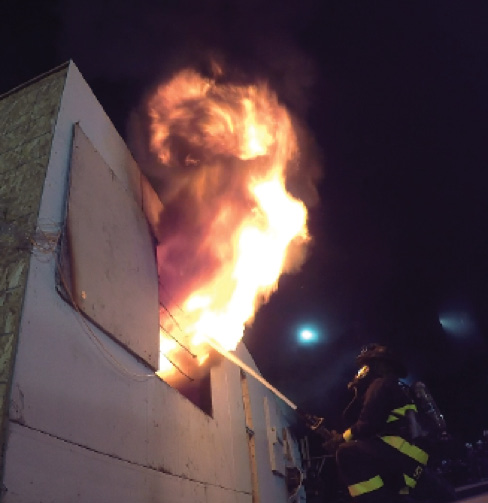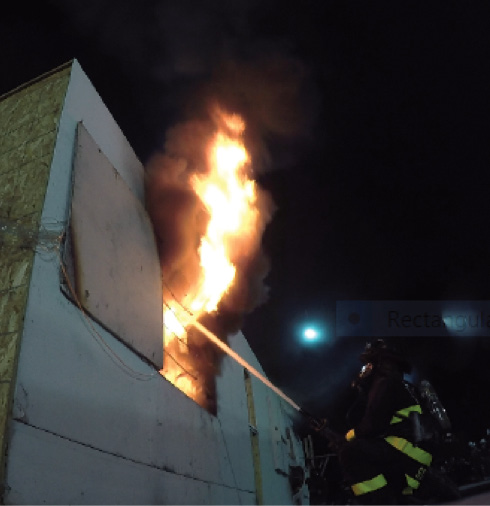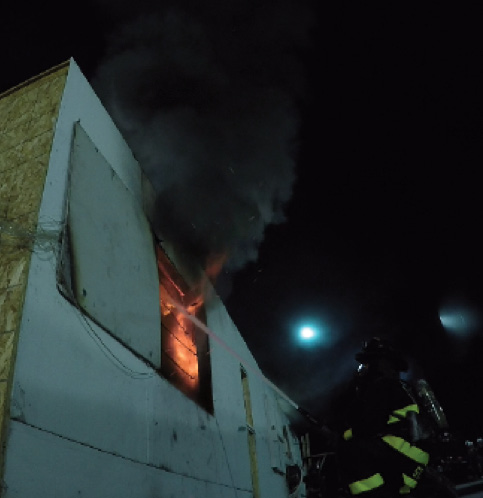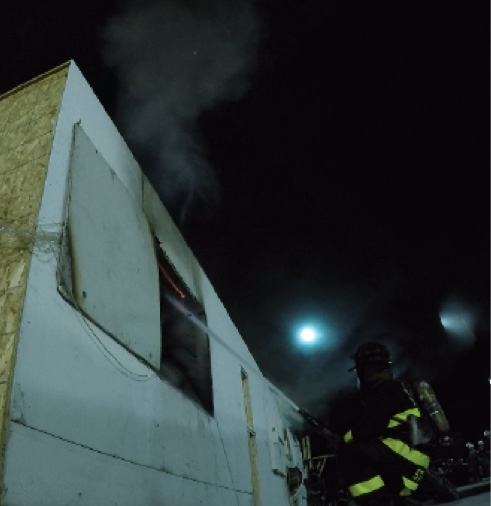
By P.J. Norwood and Nick J. Salameh
Fire attack, when properly deployed, is the function on the fireground that has the greatest impact on occupant survivability and firefighter safety. When the old adage “Put the wet stuff on the red stuff” was taught and was successful, the fire environment was not what it is today. For many years, we taught and performed fire attack the same way with little variation or advancement. These teachings and practices were passed down from generation to generation, and much of yesterday’s training was based on experience, not science. But, that’s changing, thanks to science-based advances in modern fire dynamics and modern fire tactics.
RELATED
Attic Fires: Latest Technical Panel Results
Burning Down the House: A Practical Way to Demonstrate Fire Behavior
Ventilation-Limited Fire: Keeping it Rich and Other Tactics Based on Science
Back then, like today, the fire environment was changing and becoming more volatile. The fire service looked at nozzles, nozzle movement, hose size, appliances, and pressures to fight the changing environment. At the same time, our personal protective ensemble of turnout gear and self-contained breathing apparatus was improving and allowing us to push deeper and farther into the fire environment, which offered an increased sense of security. Although we focused on work-arounds that allowed us to operate in a more hostile environment, we failed to understand the changing fire dynamics and to identify better tactics to more effectively combat modern day fires. Today’s fire science research is bridging the gap between the fire service and our understanding of modern fire dynamics, an understanding that is essential to firefighter success.
Evolving Environment
Over the years, the fire environment has been evolving. It has been influenced by the significant use of synthetics in building contents, new building construction, the use of lightweight and composite building components, less compartmentation, and more energy efficiency. Yet, despite this evolution, our understanding of fire dynamics and tactics remained static. With the help of the UL Firefighter Safety Research Institute (UL-FSRI) and the National Institute of Standards and Technology (NIST), recent and ongoing modern fire science research is adding to our experiential knowledge base through science-based findings. These findings have identified and continue to identify significant changes in fire dynamics from the legacy period to the modern era. The studies confirm the effectiveness of what are often believed to be tried-and-true tactics that are experiential based and have identified modern tactical options based in science to create tactical best practices. Today’s modern tactics focus on the best methods for applying effective water as quickly as possible, regardless of whether it comes from the interior or exterior of the structure.
In 1950, Chief Lloyd Layman presented the “Little Drops of Water” paper at the Fire Department Instructors Conference (FDIC). He introduced what he called the “indirect method of attack to suppress interior building fires by using the heat-absorbing properties of expanding and condensing steam, produced in great quantities by fog streams.”1 The conclusions were based on experiments that Layman conducted at the Coast Guard Firefighting School at Fort McHenry in Baltimore, Maryland. (1) Layman continued his experiments and applied his tactic in building fires after he returned to his position as fire chief in Parkersburg, West Virginia. This research has had a very large impact on the fire service and suppression techniques to this day.2
In 2012, during the UL-FSRI/NIST Governors Island experiments, UL Director Steve Kerber began looking at fire tactics and the use of exterior water application as part of the offensive attack mode, now referred to as the “transitional attack.” Most have become accustomed to recognizing exterior fire attack tactics as defensive actions, but the study findings were a pivotal moment in the fire service and proved that the transitional attack, when applicable, was an effective offensive attack mode tactic to quickly and initially take control of fire and to immediately improve interior conditions.
Although the debates over smooth bore vs. fog nozzle have slowed for the time being, the application of water from the exterior through transitional attack is being debated furiously. During these debates, there seems to be some confusion about what transitional attack is and is not. So, rather than debate if a transitional attack should or could be used, let’s take a closer look at what it is.
Fire Attack Modes
The two basic fire attack modes are offensive and defensive. You can easily define “attack modes” as “where the nozzle will end up.” If the fire attack starts exterior and stays exterior, it’s a defensive attack. If the fire attack ends on the interior, it’s an offensive attack.
Regardless of the fire attack mode used, whether you are using a direct or an indirect attack method is determined by how you apply the water to the environment. If water is aimed directly onto the burning materials, it is a direct attack. If the water is directed into the compartment to cool the environment or if you bank the stream when applying it into the area, it is an indirect attack.
Transitional Attack
Transitional attack is an offensive attack mode tactic. By definition, it’s an indirect attack method. Many envision the indirect attack as the directing of an exterior fog stream into a window to generate high volumes of steam to cool and smother fire. Although this is still an option, the transitional attack can be used to cool surfaces and the gas layer without producing large volumes of steam by using a solid or a straight stream to apply the water. The transitional attack is not designed to achieve knockback by producing steam. In fact, the cooling action causes gases to contract.
Evolving Definitions
Definitions Used in This Article
References
1. Smith, James P. (2008) Strategic and Tactical Considerations on the Fireground, Second Edition. Pearson.
2. Schottke, David. Fundamentals of Fire Fighter Skills. (2014) Jones and Bartlett, 1130.
3. Glossary of Terms. (2018) National Fire Protection Association, 976.
4. Ibid, 1005.
5. Zevotek, Robin; Keith Stakes, Joseph Willi. (2018) “Impact of Fire Attack Utilizing Interior and Exterior Streams on Firefighter Safety and Occupant Survival: Full Scale Experiments,” https://ulfirefightersafety.org/docs/DHS2013_Part_III_Full_Scale.pdf . UL Firefighter Safety Research Institute, 211.
6. NFPA Glossary of Terms, 1830.
7. “Impact of Fire Attack ….” 213.
8-10. Ibid., 214.
11. International Association of Fire Chiefs and National Fire Protection Association. (2014) Fundamentals of Fire Fighter Skills Enhanced, Enhanced Third Edition. (2014) Jones and Bartlett, 1142.
12. NFPA Glossary of Terms, 2,486.
13. “Impact of Fire Attack ….” 216.
Remember, you define the attack mode by where you end up, not where you start. When you choose a transitional attack, the most effective method of initially applying water to coat the most surfaces and provide the most cooling is to bank it off the ceiling at as steep an angle as possible, keeping the nozzle as steady as possible to reduce air entrainment. The nozzle firefighter should be constantly evaluating the effectiveness of the water application, looking for indications that it is having a positive effect such as knocking back flames in the gas layer within seconds. If no effect is noted, direct the nozzle from a different location—an alternate window or a door to the fire compartment) or possibly off the top of the window to coat surfaces. Once the gases have been cooled enough so that fire no longer is venting out the window (knockback), shut down the nozzle to evaluate conditions. There is no time limit or suggested flow time; base the time needed for cooling on the conditions. If the water application is no longer showing signs of effective cooling, adjust the application angle.




(1-4) These images show improved conditions after the initial application of water during a transitional attack using a smooth bore nozzle at a steep angle and directed off the ceiling. The sequence of images represents the first three seconds after the initial application of water. (1) Suppression starts, (2) one second after suppression started, (3) two seconds after suppression started, (4) and three seconds after suppression started. [Source: UL Firefighter Safety Research Institute. (2018) “Impact of Fire Attack Utilizing Interior and Exterior Streams on Firefighter Safety and Occupant Survival: Full Scale Experiments (Experiment 18),” 174.]
After effectively knocking back exterior flame, you must move quickly from the transitional attack to an interior attack to complete extinguishment, or the flame regrowth will occur. Whether repositioning the first attack line or simultaneously coordinating to have the second attack line advance to the interior, it is essential that you make a rapid and an efficient transition.
The transitional attack is not a one-size-fits-all tactic. A company officer who indiscriminately uses the transitional attack on every fireground is destined to fail. Like all strategies and tactics, it has a time and a place. An effective engine company officer will understand and use a variety of options for tactical fire attack and will chose the best tactic for each fire. Failure to apply the right tactics from the start will allow the fire instead of the firefighters to maintain control, putting firefighters in a reactive rather than a proactive stance.
For instance, if it is determined that the transitional attack is the proper tactic, failing to quickly transition the first attack line or to simultaneously coordinate the second attack line to interior attack immediately following the transitional attack will allow flame regrowth. You will not achieve a knockdown and extinguishment unless crews quickly move to the interior to completely stop the combustion process.
Some would argue that flowing water from the outside of the structure, to push in, is in essence using a transitional attack. Although it may not meet the specifics of the proper angle, it is still a transitional attack based on the definition of this fire attack method.
The Blitz Attack
Some find the blitz attack confusing. Blitz attack, as created in Chicago, is “an offensive attack used in the same manner as a transitional attack.” Some call the transitional attack “the modern blitz attack.” A traditional blitz attack may not meet the defining criteria of a transitional attack, but the goal is the same: quick, effective water from the exterior to overtake or slow the growth of fire and to create a more habitable interior environment that will allow for a rapid aggressive interior attack to complete extinguishment.
Applying What We Know
One of the most profound statements relating to fire attack in the UL-FSRI technical report (2) is on page 184, Section 7.7, “Water in the Fire Compartment Matters, and so does Timing”:
Effective application of water, whether from the interior doorway or from the exterior window, into the fire compartment has a positive impact. The heat release rate of the fire is reduced, temperatures both near and remote from the fire are reduced, and the rate at which toxic gases are produced slows, making tactical ventilation effective. With all else being equal, the tactical choice on where to apply water from should be based more on the time it takes to knock back the fire and less on the position the water is being applied from.
The time has come to stop arguing over what we call something and put our energy into learning the when and how to effectively apply water to our firegrounds in the quickest way possible. We need to analyze how we deploy our attack lines, use available personnel and resources, and perform fire attack at every fire. There is no one-size-fits-all tactic for every fire. Although every fire burns in a predictable manner, the fire environment and what each department faces on arrival are different. Therefore, each department must quickly analyze each fire and deploy the best strategy and tactics for each situation.
The primary goal “to save lives” remains unchanged. However, we must effectively apply sufficient water into the fire area as quickly as possible to immediately improve interior conditions for savable trapped occupants and for firefighter effectiveness, efficiency, and improved safety. Do what’s right for the fire you’re on, not necessarily what you’ve always done.
References
1. Lloyd Layman, editor. (1952) Attacking and Extinguishing Interior Fires. National Fire Protection Association.
2. Zevotek, Robin, Keith Stakes, and Joseph Willi. (2018) UL Firefighter Safety Research Institute. “Impact of Fire Attack Utilizing Interior and Exterior Streams on Firefighter Safety and Occupant Survival: Full Scale Experiments,” https://ulfirefightersafety.org/docs/DHS2013_Part_III_Full_Scale.pdf/10, 3.2.1 Fire Suppression Methods.
P.J. Norwood is a deputy chief training officer for the East Haven (CT) Fire Department and has served four years with the Connecticut Army National Guard. He is an FDIC International classroom, workshop, and H.O.T. instructor and a Fire Engineering advisory board member. He is the author of The Evolving Fireground-Researched Based Tactics and the Tactical Perspectives DVD Series (Fire Engineering). He is a member of the UL-FSRI Technical Panel for the Study of Residential Attic Fire Mitigation Tactics and Exterior Fire Spread Hazards on Fire Fighter Safety and a member of its Public Safety Education Group advisory board. He has lectured internationally and is certified to the instructor II, officer III, fire marshal, and paramedic levels.
Nick J. Salameh is a 36-year veteran of the fire service. He was a fire/emergency medical services captain II and a training program manager for the Arlington County (VA) Fire Department, with which he served for 31 years. He is a former chair of the Northern Virginia Fire Departments Training Committee. He is a contributor to Fire Engineering and Stop Believing Start Knowing.

